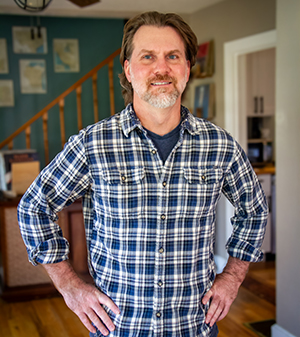A Haunting: Rebeca Dunn-Krahn interviews Ryan Cannon

Volunteer Rebeca Dunn-Krahn talks with Ryan Cannon, winner of our 2024 Novella Prize with "A Hunting Story," featured in our summer issue #227. They discuss building a sensory narrative, providing an engine of causality, and taking your characters with you into the wilderness.
Ryan Cannon is a storyteller working in film and fiction. He received an MFA in writing from the University of Texas at Austin, where he was a James A. Michener Fellow. A working screenwriter, Ryan’s screenplays have been optioned and developed by major production companies in Los Angeles and New York. His stories have appeared most recently in Alaska Quarterly Review, Willow Springs, and Narrative Magazine. He lives in Idaho and teaches film at Boise State University.
I read your winning novella, “A Hunting Story,” with great pleasure, and enjoyed it even more the second time. The story is very interior, but told in a cinematic way, with vivid colour and tactile detail. The weather and landscape feel like characters unto themselves. It made perfect sense when I learned that you also work in, and teach, film. What is your process for building a sensory narrative like this?
Thank you so much for the question, Rebeca, and for the kind words.
I worked on this story on and off over a number of years, and in that period spent a good bit of time in the Idaho mountains, including a few weeks getting drenched in the panhandle. (The misery of unrelenting rain in the story, I hope, feels lived.) I did try to convey a strong sense of place, and also to filter the details of the landscape through the characters, intending that we would experience this particular wilderness through a slightly heightened and close lens via the limited (sometimes unreliable) perspectives of the brothers.
As I had the piece in process for so long, I could carry the story and the characters with me into the mountains. I’d take notes, imagine where they would walk, what they would see, hear, smell, feel, and then do my best to infuse those details back into the story via the three brothers. In the moment, this can feel a little ridiculous, as I might find myself sitting in a downpour on the mountainside wondering how exactly to convey the sound of crow’s wings flying overhead. Or, let me jot down impressions of all twenty of these mushrooms. Very little of that stuff was generative, but images and sounds and moments I had gathered. My hope is that, like a mosaic, as the small details add up, they provide a complete and compelling impression of the landscape.
As a reader, I appreciate when a novella combines the efficiency of a short story with the depth of a novel. Do you often work on stories of this length? What special challenges does the novella form present to the writer?
Well, shoot, I did my best not to write a novella. And failed, happily failed. Naturally, I think many folks who write novellas or even longer pieces of short fiction may fear, as I did, that the work will end up in a desk drawer, or whatever the digital equivalent of a desk drawer is. My deep appreciation and thanks to The Malahat Review for providing a platform for new novellas, and for giving a home to this particular story.
As I began sketching the piece, I found a few short-story-size shapes it could perhaps assume, but as I drafted, I quickly found myself writing sections that split into the perspective of each brother. Whether this was the thing to do or not, certainly debateable, but I liked it, and found myself pulled into three separate but overlapping backstories and front stories. I certainly wrestled with this aspect—how to balance the stories of the brothers, how to interweave them, how much leniency would a reader grant me to digress into not one but three character histories. The story swelled from there in scope, though I aimed to retain the concision and velocity that I most admire in short fiction.
The story offers an unflinching but compassionate reflection on modern fatherhood, with four father characters that have the odds stacked against them. Why was it important that the three brothers all have daughters?
The conceit for the story began for me simply enough: a hunter finds an image of a girl on a game camera. Is she lost? Is she in trouble? What does the hunter do next?
From there the story evolved. The hunter became hunters, and they became brothers. I thought at first I was most interested in the relationship between the brothers, which would reveal itself as they grappled with what to do next, but as I dug into what the missing girl would mean to them, they became fathers, then fathers to daughters. Their various tragedies emerged, as did their various culpabilities. The brothers’ relationship, though important, took a back seat to what each grappled with individually. In fact, their trauma isolated them from one another, and the story ends aptly with each brother alone. Ultimately, I hoped the story would explore their troubled and troubling roles as fathers and sons. I wanted to fill the mountain around the brothers with the absence of women—their daughters, their daughter’s mothers, their own mother—hinged upon and triggered by the photo of the girl on the game camera. It becomes a haunting of sorts, literally for one brother and figuratively for the others.
You also work as a screenwriter. What secret weapons of screenwriting should fiction and creative nonfiction writers know about?
There is definitely a shifting of gears that takes place when moving from one form to the other, but I find each enriching. Screenwriting restricts the writer from interiority, which is a great exercise, to find ways centered upon action and reaction and causality that externalize the character. I love the frisson that occurs when we find disparities between the interiority of a character and what they actually do. Psychological realism, while the bedrock of so much storytelling, can also become a blank wall. Who, after all, knows themselves completely?
When I write anything, fiction or screenplay, I aim to be acutely aware of what is driving the story at any given moment, and what question is fore in the mind of the reader. What happens next? How did we get here? There are certainly stories and writers that function beautifully with a slenderness of narrative, without relying on Aristotelian tenants, and I’m generally in awe of that work. For me, I hope that by providing the story an engine of causality, the tension of plot, the reader will be more inclined to forgive my other multitude of shortcomings.
Which storytellers have been inspiring your work lately?
Women Talking, first the Miriam Toews novel and then the Sarah Polley film adaptation. Both are brilliant and devastating, how the narrative is composed nearly entirely of dialogue, all hung upon a single pressing and all-important dramatic question. Though I miss the more intricate tragedy of the narrator, August, that is lost in the film adaptation, the visually lyrical interludes of life on the Mennonite colony in the film contribute a deep sense of place and pleasure and lost innocence. Ling Ma’s story collection, Bliss Montage, is equally remarkable. Talk about concision and velocity. Her stories are tightly constructed, ferociously imaginative, full of pathos and wit. (In “Los Angeles,” the husband who talks only in dollar signs!) And speaking of fathers and daughters, Charlotte Well’s film, Aftersun, has left a burning impression upon me, particularly for the nuances of the two main characters’ relationship, and the bold narrative structure that ultimately proves to be devastating when the film’s perspective is revealed.

Rebeca Dunn-Krahn









